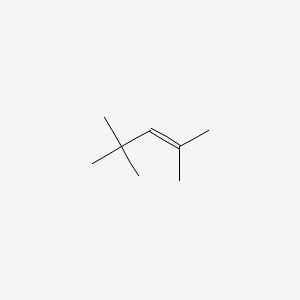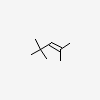2,4,4-Trimethyl-2-pentene
- C8H16
- CH3C(CH3)=CHC(CH3)3
- 2,4,4-TRIMETHYL-2-PENTENE
- 107-40-4
- 2,4,4-Trimethylpent-2-ene
- 2-Pentene, 2,4,4-trimethyl-
- 2,2,4-Trimethyl-3-pentene
- Create:2005-03-27
- Modify:2024-12-27

C8H16
CH3C(CH3)=CHC(CH3)3
- 2,4,4-TRIMETHYL-2-PENTENE
- 107-40-4
- 2,4,4-Trimethylpent-2-ene
- 2-Pentene, 2,4,4-trimethyl-
- 2,2,4-Trimethyl-3-pentene
- 2,4,4-Trimethylpentene-2
- HSDB 5377
- UNII-548R0DU21I
- DTXSID9026766
- 548R0DU21I
- Propene, 1-tert-butyl-2-methyl-
- EINECS 203-488-5
- .BETA.-DIISOBUTYLENE
- AI3-16047
- DTXCID206766
- (CH3)3CCH=C(CH3)2
- beta-Diisobutylene
- MFCD00008902
- -Diisobutylene
- 1Methyl1neopentylethylene
- 2,2,4Trimethyl3pentene
- 2,2,4Trimethyl4pentene
- 2,4,4Trimethyl1pentene
- 2,4,4Trimethylpentene2
- Propene, 1tertbutyl2methyl
- 1Pentene, 2,4,4trimethyl
- 2Pentene, 2,4,4trimethyl
- CHEMBL3187575
- Tox21_200795
- 2,4,4-Trimethyl-2-pentene, 99%
- AKOS015903732
- NCGC00248835-01
- NCGC00258349-01
- CAS-107-40-4
- LS-13497
- NS00023459
- T0780
- D92393
- J-001895
- Q1674518
- Antioxidant
- Solvent
- Intermediate
- Fuel agents
- Not Known or Reasonably Ascertainable
- Intermediates
- Lubricating agent
2019: 20,000,000 lb - <100,000,000 lb
2018: 20,000,000 lb - <100,000,000 lb
2017: 20,000,000 lb - <100,000,000 lb
2016: 20,000,000 lb - <100,000,000 lb
2017: 63,550 lb
2016: 105,728 lb
- All Other Basic Organic Chemical Manufacturing
- Paint and Coating Manufacturing
- Wholesale and Retail Trade
- Not Known or Reasonably Ascertainable
- Plastics Material and Resin Manufacturing
- Petrochemical Manufacturing
- Soap, Cleaning Compound, and Toilet Preparation Manufacturing
- Rubber Product Manufacturing




H225 (100%): Highly Flammable liquid and vapor [Danger Flammable liquids]
H304 (64%): May be fatal if swallowed and enters airways [Danger Aspiration hazard]
H315 (66%): Causes skin irritation [Warning Skin corrosion/irritation]
H319 (66%): Causes serious eye irritation [Warning Serious eye damage/eye irritation]
H335 (66%): May cause respiratory irritation [Warning Specific target organ toxicity, single exposure; Respiratory tract irritation]
H336 (44.2%): May cause drowsiness or dizziness [Warning Specific target organ toxicity, single exposure; Narcotic effects]
H411 (46.2%): Toxic to aquatic life with long lasting effects [Hazardous to the aquatic environment, long-term hazard]
P210, P233, P240, P241, P242, P243, P261, P264, P264+P265, P271, P273, P280, P301+P316, P302+P352, P303+P361+P353, P304+P340, P305+P351+P338, P319, P321, P331, P332+P317, P337+P317, P362+P364, P370+P378, P391, P403+P233, P403+P235, P405, and P501
(The corresponding statement to each P-code can be found at the GHS Classification page.)
Aggregated GHS information provided per 197 reports by companies from 6 notifications to the ECHA C&L Inventory. Each notification may be associated with multiple companies.
Information may vary between notifications depending on impurities, additives, and other factors. The percentage value in parenthesis indicates the notified classification ratio from companies that provide hazard codes. Only hazard codes with percentage values above 10% are shown.
Flam. Liq. 2 (100%)
Asp. Tox. 1 (64%)
Skin Irrit. 2 (66%)
Eye Irrit. 2 (66%)
STOT SE 3 (66%)
STOT SE 3 (44.2%)
Aquatic Chronic 2 (46.2%)
Flam. Liq. 2 (82.5%)
Asp. Tox. 1 (78.8%)
STOT SE 3 (78.5%)
Aquatic Acute 1 (66.6%)
Aquatic Chronic 1 (66.6%)

Excerpt from ERG Guide 128 [Flammable Liquids (Water-Immiscible)]:
HIGHLY FLAMMABLE: Will be easily ignited by heat, sparks or flames. Vapors may form explosive mixtures with air. Vapors may travel to source of ignition and flash back. Most vapors are heavier than air. They will spread along the ground and collect in low or confined areas (sewers, basements, tanks, etc.). Vapor explosion hazard indoors, outdoors or in sewers. Those substances designated with a (P) may polymerize explosively when heated or involved in a fire. Runoff to sewer may create fire or explosion hazard. Containers may explode when heated. Many liquids will float on water. Substance may be transported hot. For hybrid vehicles, ERG Guide 147 (lithium ion or sodium ion batteries) or ERG Guide 138 (sodium batteries) should also be consulted. If molten aluminum is involved, refer to ERG Guide 169. (ERG, 2024)
Excerpt from ERG Guide 128 [Flammable Liquids (Water-Immiscible)]:
CAUTION: The majority of these products have a very low flash point. Use of water spray when fighting fire may be inefficient. CAUTION: For mixtures containing alcohol or polar solvent, alcohol-resistant foam may be more effective.
SMALL FIRE: Dry chemical, CO2, water spray or regular foam. If regular foam is ineffective or unavailable, use alcohol-resistant foam.
LARGE FIRE: Water spray, fog or regular foam. If regular foam is ineffective or unavailable, use alcohol-resistant foam. Avoid aiming straight or solid streams directly onto the product. If it can be done safely, move undamaged containers away from the area around the fire.
FIRE INVOLVING TANKS, RAIL TANK CARS OR HIGHWAY TANKS: Fight fire from maximum distance or use unmanned master stream devices or monitor nozzles. Cool containers with flooding quantities of water until well after fire is out. For petroleum crude oil, do not spray water directly into a breached tank car. This can lead to a dangerous boil over. Withdraw immediately in case of rising sound from venting safety devices or discoloration of tank. ALWAYS stay away from tanks in direct contact with flames. For massive fire, use unmanned master stream devices or monitor nozzles; if this is impossible, withdraw from area and let fire burn. (ERG, 2024)
Excerpt from ERG Guide 128 [Flammable Liquids (Water-Immiscible)]:
IMMEDIATE PRECAUTIONARY MEASURE: Isolate spill or leak area for at least 50 meters (150 feet) in all directions.
LARGE SPILL: Consider initial downwind evacuation for at least 300 meters (1000 feet).
FIRE: If tank, rail tank car or highway tank is involved in a fire, ISOLATE for 800 meters (1/2 mile) in all directions; also, consider initial evacuation for 800 meters (1/2 mile) in all directions. (ERG, 2024)
Excerpt from ERG Guide 128 [Flammable Liquids (Water-Immiscible)]:
ELIMINATE all ignition sources (no smoking, flares, sparks or flames) from immediate area. All equipment used when handling the product must be grounded. Do not touch or walk through spilled material. Stop leak if you can do it without risk. Prevent entry into waterways, sewers, basements or confined areas. A vapor-suppressing foam may be used to reduce vapors. Absorb or cover with dry earth, sand or other non-combustible material and transfer to containers. Use clean, non-sparking tools to collect absorbed material.
LARGE SPILL: Dike far ahead of liquid spill for later disposal. Water spray may reduce vapor, but may not prevent ignition in closed spaces. (ERG, 2024)
Patents are available for this chemical structure:
https://patentscope.wipo.int/search/en/result.jsf?inchikey=LAAVYEUJEMRIGF-UHFFFAOYSA-N
- Australian Industrial Chemicals Introduction Scheme (AICIS)2-Pentene, 2,4,4-trimethyl-https://services.industrialchemicals.gov.au/search-inventory/
- CAMEO ChemicalsLICENSECAMEO Chemicals and all other CAMEO products are available at no charge to those organizations and individuals (recipients) responsible for the safe handling of chemicals. However, some of the chemical data itself is subject to the copyright restrictions of the companies or organizations that provided the data.https://cameochemicals.noaa.gov/help/reference/terms_and_conditions.htm?d_f=falseDIISOBUTYLENE, ISOMERIC COMPOUNDShttps://cameochemicals.noaa.gov/chemical/3225
- ILO-WHO International Chemical Safety Cards (ICSCs)2,4,4-TRIMETHYL-2-PENTENEhttps://www.ilo.org/dyn/icsc/showcard.display?p_version=2&p_card_id=0737
- CAS Common ChemistryLICENSEThe data from CAS Common Chemistry is provided under a CC-BY-NC 4.0 license, unless otherwise stated.https://creativecommons.org/licenses/by-nc/4.0/2,4,4-Trimethyl-2-pentenehttps://commonchemistry.cas.org/detail?cas_rn=107-40-4
- ChemIDplus2,4,4-Trimethyl-2-pentenehttps://pubchem.ncbi.nlm.nih.gov/substance/?source=chemidplus&sourceid=0000107404ChemIDplus Chemical Information Classificationhttps://pubchem.ncbi.nlm.nih.gov/source/ChemIDplus
- EPA Chemical Data Reporting (CDR)LICENSEThe U.S. Government retains a nonexclusive, royalty-free license to publish or reproduce these documents, or allow others to do so, for U.S. Government purposes. These documents may be freely distributed and used for non-commercial, scientific and educational purposes.https://www.epa.gov/web-policies-and-procedures/epa-disclaimers#copyrightPentene, 2,4,4-trimethyl-https://www.epa.gov/chemical-data-reporting
- EPA Chemicals under the TSCA2-Pentene, 2,4,4-trimethyl-https://www.epa.gov/chemicals-under-tscaEPA TSCA Classificationhttps://www.epa.gov/tsca-inventory
- EPA DSSTox2,4,4-Trimethyl-2-pentenehttps://comptox.epa.gov/dashboard/DTXSID9026766CompTox Chemicals Dashboard Chemical Listshttps://comptox.epa.gov/dashboard/chemical-lists/
- EPA Provisional Peer-Reviewed Toxicity Values (PPRTVs)2,4,4-Trimethylpentenehttps://cfpub.epa.gov/ncea/pprtv/chemicalLanding.cfm?pprtv_sub_id=1949
- European Chemicals Agency (ECHA)LICENSEUse of the information, documents and data from the ECHA website is subject to the terms and conditions of this Legal Notice, and subject to other binding limitations provided for under applicable law, the information, documents and data made available on the ECHA website may be reproduced, distributed and/or used, totally or in part, for non-commercial purposes provided that ECHA is acknowledged as the source: "Source: European Chemicals Agency, http://echa.europa.eu/". Such acknowledgement must be included in each copy of the material. ECHA permits and encourages organisations and individuals to create links to the ECHA website under the following cumulative conditions: Links can only be made to webpages that provide a link to the Legal Notice page.https://echa.europa.eu/web/guest/legal-notice2,4,4-trimethylpentenehttps://chem.echa.europa.eu/100.042.4312,4,4-trimethylpent-2-enehttps://echa.europa.eu/substance-information/-/substanceinfo/100.003.1722,4,4-trimethylpent-2-ene (EC: 203-488-5)https://echa.europa.eu/information-on-chemicals/cl-inventory-database/-/discli/details/364272,4,4-trimethylpentene (EC: 246-690-9)https://echa.europa.eu/information-on-chemicals/cl-inventory-database/-/discli/details/84725
- FDA Global Substance Registration System (GSRS)LICENSEUnless otherwise noted, the contents of the FDA website (www.fda.gov), both text and graphics, are not copyrighted. They are in the public domain and may be republished, reprinted and otherwise used freely by anyone without the need to obtain permission from FDA. Credit to the U.S. Food and Drug Administration as the source is appreciated but not required.https://www.fda.gov/about-fda/about-website/website-policies#linking2,4,4-TRIMETHYL-2-PENTENEhttps://gsrs.ncats.nih.gov/ginas/app/beta/substances/548R0DU21I
- Hazardous Substances Data Bank (HSDB)2,4,4-TRIMETHYL-2-PENTENEhttps://pubchem.ncbi.nlm.nih.gov/source/hsdb/5377
- New Zealand Environmental Protection Authority (EPA)LICENSEThis work is licensed under the Creative Commons Attribution-ShareAlike 4.0 International licence.https://www.epa.govt.nz/about-this-site/general-copyright-statement/
- NJDOH RTK Hazardous Substance List
- Haz-Map, Information on Hazardous Chemicals and Occupational DiseasesLICENSECopyright (c) 2022 Haz-Map(R). All rights reserved. Unless otherwise indicated, all materials from Haz-Map are copyrighted by Haz-Map(R). No part of these materials, either text or image may be used for any purpose other than for personal use. Therefore, reproduction, modification, storage in a retrieval system or retransmission, in any form or by any means, electronic, mechanical or otherwise, for reasons other than personal use, is strictly prohibited without prior written permission.https://haz-map.com/AboutDiisobutylenehttps://haz-map.com/Agents/29762,4,4-Trimethyl-2-pentenehttps://haz-map.com/Agents/2977
- ChEMBLLICENSEAccess to the web interface of ChEMBL is made under the EBI's Terms of Use (http://www.ebi.ac.uk/Information/termsofuse.html). The ChEMBL data is made available on a Creative Commons Attribution-Share Alike 3.0 Unported License (http://creativecommons.org/licenses/by-sa/3.0/).http://www.ebi.ac.uk/Information/termsofuse.html
- EPA Regional Screening Levels for Chemical Contaminants at Superfund SitesTrichlorophenoxypropionic acid, -2,4,5https://epa-prgs.ornl.gov/cgi-bin/chemicals/csl_searchTrimethylbenzene, 1,2,4-https://epa-prgs.ornl.gov/cgi-bin/chemicals/csl_search?tool=rml
- Hazardous Chemical Information System (HCIS), Safe Work Australia2,4,4-trimethylpentenehttp://hcis.safeworkaustralia.gov.au/HazardousChemical/Details?chemicalID=4762
- NITE-CMC2,4,4-Trimethylpent-2-ene - FY2011 (New/original classication)https://www.chem-info.nite.go.jp/chem/english/ghs/11-mhlw-0046e.htmlDiisobutylene (Isomer mixture) - FY2021 (New/original classication)https://www.chem-info.nite.go.jp/chem/english/ghs/21-moe-0003e.html
- Regulation (EC) No 1272/2008 of the European Parliament and of the CouncilLICENSEThe copyright for the editorial content of this source, the summaries of EU legislation and the consolidated texts, which is owned by the EU, is licensed under the Creative Commons Attribution 4.0 International licence.https://eur-lex.europa.eu/content/legal-notice/legal-notice.html2,4,4-trimethylpentenehttps://eur-lex.europa.eu/eli/reg/2008/1272/oj
- NMRShiftDB
- Japan Chemical Substance Dictionary (Nikkaji)
- Nature Synthesis
- NIST Mass Spectrometry Data CenterLICENSEData covered by the Standard Reference Data Act of 1968 as amended.https://www.nist.gov/srd/public-law2-Pentene, 2,4,4-trimethyl-http://www.nist.gov/srd/nist1a.cfm
- SpectraBase2-PENTENE, 2,4,4-TRIMETHYL-https://spectrabase.com/spectrum/IysjNPMsB1x2-Pentene, 2,4,4-trimethyl-https://spectrabase.com/spectrum/I7huegKO7l52,4,4-TRIMETHYL-2-PENTENEhttps://spectrabase.com/spectrum/3cfbBFiFF4D2,4,4-trimethyl-2-pentenehttps://spectrabase.com/spectrum/IlTopNMrQlf2,4,4-TRIMETHYL-2-PENTENEhttps://spectrabase.com/spectrum/9cE26r4mI8W2-PENTENE, 2,4,4-TRIMETHYL-https://spectrabase.com/spectrum/HC6a1u61M0e2,4,4-TRIMETHYL-2-PENTENEhttps://spectrabase.com/spectrum/5JdBlu7Nhjw2,4,4-Trimethyl-2-pentenehttps://spectrabase.com/spectrum/KQ0gfBDVJQu2-PENTENE, 2,4,4-TRIMETHYL-,https://spectrabase.com/spectrum/1b3VKDM7ok52,4,4-Trimethyl-2-pentenehttps://spectrabase.com/spectrum/A8wAk36CZPo2,4,4-Trimethyl-2-pentenehttps://spectrabase.com/spectrum/DwPQxvgn0pj2,4,4-Trimethyl-2-pentenehttps://spectrabase.com/spectrum/23dnx2yh0q0
- Springer Nature
- SpringerMaterials2,4,4-trimethyl-2-pentenehttps://materials.springer.com/substanceprofile/docs/smsid_vvobgvazaatmnieq
- Thieme ChemistryLICENSEThe Thieme Chemistry contribution within PubChem is provided under a CC-BY-NC-ND 4.0 license, unless otherwise stated.https://creativecommons.org/licenses/by-nc-nd/4.0/
- Wikidata2,4,4-trimethyl-2-pentenehttps://www.wikidata.org/wiki/Q1674518
- Wiley
- PubChem
- GHS Classification (UNECE)GHS Classification Treehttp://www.unece.org/trans/danger/publi/ghs/ghs_welcome_e.html
- NORMAN Suspect List ExchangeLICENSEData: CC-BY 4.0; Code (hosted by ECI, LCSB): Artistic-2.0https://creativecommons.org/licenses/by/4.0/NORMAN Suspect List Exchange Classificationhttps://www.norman-network.com/nds/SLE/
- EPA Substance Registry ServicesEPA SRS List Classificationhttps://sor.epa.gov/sor_internet/registry/substreg/LandingPage.do
- MolGenieMolGenie Organic Chemistry Ontologyhttps://github.com/MolGenie/ontology/
- PATENTSCOPE (WIPO)SID 403424543https://pubchem.ncbi.nlm.nih.gov/substance/403424543

